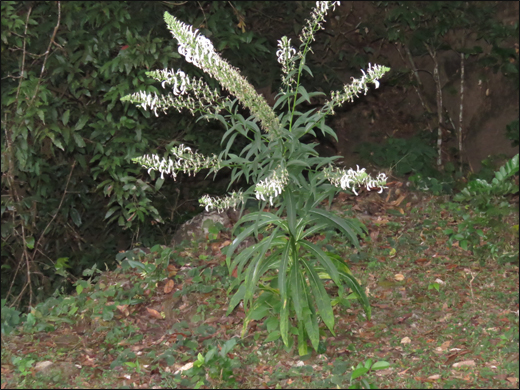Wild tobacco/ Lobelia nicotianaefolia Heyne – Properties, Benefits & Dosage
Abstract
Lobelia nicotianaefolia Heyne, commonly known as Wild Tobacco, is a herbaceous plant belonging to the family Campanulaceae. It is found in the wild, particularly in the Western Ghats and parts of peninsular India. Traditionally, this plant has been valued for its medicinal applications in Ayurveda and folk medicine. Traditionally, the plant has been used to manage colds and various respiratory ailments. One of its key active compounds, lobeline, has shown effectiveness in treating conditions such as asthma, pneumonia, and neonatal asphyxia. This article explores its botanical features, chemical constituents, therapeutic applications, and dosage. Emphasis is also placed on its vernacular use and home remedies in traditional healthcare systems.

Introduction
Wild Tobacco, scientifically named Lobelia nicotianaefolia, is a medicinal plant with significant ethnobotanical relevance in India. Though it resembles true tobacco (Nicotiana spp.), it belongs to a different genus and contains distinct chemical constituents. The plant has also been used as an emetic and sedative due to its strong physiological effects. Its use, however, must be cautious due to its potency and potential toxicity in high doses. While not well-known in mainstream herbal medicine, it has rich potential for research and therapeutic applications. Ongoing research is also exploring the potential of lobeline in addressing psychological disorders, including substance abuse, smoking cessation, and neurodegenerative conditions like Alzheimer’s disease. This article aims to provide a detailed overview of its properties, uses, and safety considerations.
Scientific Classification
- Kingdom: Plantae
- Clade: Angiosperms
- Clade: Eudicots
- Order: Asterales
- Family: Campanulaceae (formerly Lobeliaceae)
- Genus: Lobelia
- Species: Lobelia nicotianaefolia Heyne
Synonyms
- Nala
- Potgala
- Shunyamadhya
- Dhaman
- Narsal
Vernacular Names
- English: Wild Tobacco
- Hindi: Jungli Tambaku
- Marathi: Ran Tambakhu
- Kannada: Kaadu Hoggè
- Tamil: Kattu Pugaiyilai
- Telugu: Adavi Pogaku
- Malayalam: Kattu Pukayila
Habitat
Lobelia nicotianaefolia thrives in tropical and subtropical regions, particularly in the Indo-Malaysian zone and Sri Lanka. In India, it is commonly found growing wild in the Western Ghats, Eastern Ghats, and other hilly terrains at altitudes ranging from 700 to 2200 meters above sea level.
Morphology
Lobelia nicotianaefolia is a robust, hairy, biennial or perennial herb that can grow up to 1–2 meters in height. The plant has an erect, branched stem covered with coarse hairs, giving it a rough texture. Its leaves are large, ovate-lanceolate, and resemble those of tobacco plants, hence the name “Wild Tobacco.” The leaves are alternately arranged, with toothed margins and a prominent midrib. Flowers are small, tubular, and bluish-purple, arranged in terminal or axillary racemes. The calyx is five-lobed, and the corolla is irregular with a distinctive split. The plant produces a small, capsule-like fruit containing numerous minute seeds. Its overall appearance is coarse and somewhat weedy, yet easily distinguishable due to its large, tobacco-like leaves and bluish flowers.
Classical Categorisation
- According to Bhavprakash Nighantu – Guduchyadi Varga
Ancient Verses
नलस्तु मधुरस्तिक्तः कषायः कफरक्तजित ।
उष्णो हृद्बस्तियोन्यर्तिदाहपितविसर्पहृत।।
(Bhavprakash Nighantu Guduchyadi Varga 157)
Ayurvedic Properties
- Taste (Rasa) – Bitter (Tikta), Astringent (Kashaya), Sweet (Madhur)
- Physical property (Guna) – Light (Laghu), Sharp (Teekshna)
- Potency (Veerya) – Hot Potency (Usna)
- Post-digestion effect (Vipaka) – Katu (Pungent)
- Effect on tridosha – Balance Vata and Kapha dosha
Therapeutic Properties
- Expectorant
- Antiasthmatic
- Nervine
- Antispasmodic
- Analgesic
- Emetic (in higher doses)
- Anthelmintic
- Anti-inflammatory
- Sedative
- Bronchodilator
Systemic Actions
- Skin and External Use: Applied topically for swelling, insect bites, and inflammation.
Internal Uses
- Respiratory System: Acts as an expectorant, bronchodilator, and relieves bronchial congestion; useful in asthma and chronic cough.
- Nervous System: Functions as a nervine tonic and mild sedative; used in conditions like epilepsy and neuralgic pain.
- Digestive System: Stimulates digestion in low doses; acts as an emetic and purgative in higher doses.
- Musculoskeletal System: Provides analgesic and antispasmodic effects; helps relieve muscle cramps and joint pain.
- Circulatory System: Mildly stimulates circulation due to its warming potency.
- Reproductive System: Traditionally used to relieve spasmodic dysmenorrhea (painful menstruation).
Chemical Composition
- Lobeline
- Lobelanine
- Lobelanidine
- Lobelamine
- Norlobelanine
- Lelobanidine
- Norlelobanidine
- Norlobelanidine
- Lobinine
- Isolobelanine
- Lelobanidine
- Lovinine
- Isolobinine
- Lobinanidine
Practical Uses
- Asthma and Cough Relief: A small quantity of dried leaf powder is mixed with honey and taken once daily to ease bronchial congestion.
- Herbal Smoke (for asthma): Dried leaves are smoked in minute quantities as a traditional remedy to open airways during asthma attacks.
- Topical Pain Relief: Leaf paste is applied externally to swollen joints or areas of muscle pain for its anti-inflammatory and analgesic effects.
- Insect Bite Soothing: Crushed fresh leaves are applied on insect bites to reduce itching and swelling.
- Worm Infestation (Krimi): A decoction of the root in low doses is used as a traditional anthelmintic (under guidance).
- Fever and Cold: Warm decoction of leaves, taken in small quantities, is believed to help relieve fever and respiratory discomfort.
- Mental Fatigue: In folk traditions, microdoses of the plant are used to support mental alertness and reduce stress-related fatigue.
Part Used
Whole plant
Dosage
- Bark Powder – 60-185 mg
- Tincture – 5-15 Drops
Conclusion
Lobelia nicotianaefolia Heyne, holds considerable therapeutic value rooted in traditional and folk practices. Its rich alkaloid content, especially lobeline and its derivatives, contributes to its notable effects on the respiratory and nervous systems. The plant demonstrates promising pharmacological potential, particularly in conditions like asthma, epilepsy, and muscular pain. While its use is more prevalent in ethnomedicinal contexts, emerging scientific studies are beginning to validate its historical applications. Given its potent bioactive compounds, it demands careful administration and further clinical evaluation. Continued research and integration into modern herbal pharmacopoeias could help unlock its full medicinal promise.



